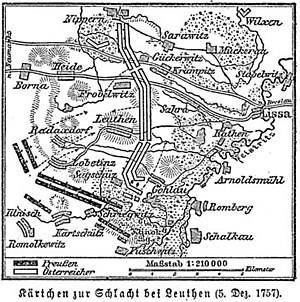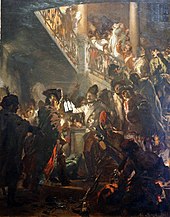Battle of Leuthen
| date | December 5, 1757 |
|---|---|
| place | Leuthen in Silesia |
| output | Prussian victory |
| Parties to the conflict | |
|---|---|
| Commander | |
| Troop strength | |
| 35,000 | 66,000 |
| losses | |
|
6,400 |
22,000 (including 12,000 prisoners) |
Eastern theater of war
Pirna - Lobositz - Prague - Kolin - Groß-Jägersdorf - Moys - Roßbach - Breslau - Leuthen - Domstadtl - Olmütz - Zorndorf - Hochkirch - Kay - Kunersdorf - Hoyerswerda - Maxen - Koßdorf - Landeshut - Liegnitz - Oschatz - Berlin - Wittenberg - Torgau- Döbeln - Burkersdorf - Reichenbach - Freiberg
The Battle of Leuthen took place on December 5, 1757 during the Seven Years' War near Leuthen in Silesia. In it the Prussian King Friedrich II defeated the Austrian army under the leadership of Prince Karl Alexander of Lorraine .
prehistory

Frederick's campaign plan for 1757 had planned to quickly defeat the main opponent Austria in Bohemia , so that this could not get any help from France and Russia . After several defeats, Friedrich found himself in a defensive position in the autumn of 1757, until he was able to surprisingly win an overwhelming victory over a French and an Imperial Execution Army in the Battle of Roßbach on November 5, 1757 and drive them out of Thuringia . From there Friedrich moved to Bohemia and on the way united his troops on December 2nd with the remnants of the "Silesian Army" under his brother-in-law, Prince August Wilhelm von Braunschweig-Bevern, who were defeated in the Battle of Breslau on November 22nd was. Friedrich's goal was to regain possession of the strategically and economically valuable province of Silesia , especially its capital, Wroclaw , through a targeted advance . He explained the paramount importance of this goal in an address to his generals shortly before the battle in the field camp in Parchwitz . In operational terms, Friedrich wanted to deny the troops of Karl Alexander the winter quarters in Breslau.
course
Near Leuthen the numerically far superior Austrians took up a position almost nine kilometers wide and let the Prussians move across. Friedrich himself estimated the number of his opponents at 39,000 men. The battlefield was open, flat terrain with hills to the west.
Friedrich initially had the left wing of the Prussian army carried out mock attacks, whereupon Karl Alexander ordered his reserves to this point. Friedrich then had his right wing, hidden behind hills and not even noticed by the Austrian Enlightenment, march south as the main power. South of the left Austrian wing and south-south-west of Leuthen, the Prussian army swung into a crooked order of battle . The right wing was by far the strongest part of the army: the cavalry under Hans Joachim von Zieten was deployed there, protected by three battalions as preliminary meetings and supported by a battery of twelve-pound cannons. The majority of the infantry meanwhile formed the left wing and was supposed to intercept the Austrian counterattack. With this formation, Friedrich succeeded in gaining superiority at a crucial point on the battlefield despite being outnumbered. In addition, he had the advantage of being surprised by the covert movement of his troops, and the Prussians succeeded in the further course of the then still unfamiliar maneuver of changing the position of the artillery during the battle. Around noon, Friedrich had his right wing attack the Austrian south wing, which was grouped near the village of Sagschütz .
When the assault on the left wing of the Austrians began, their front was torn apart by the fragmentation in the north in such a way that even the resistance of some cavalry units under General Franz Leopold von Nádasdy could not prevent the surprising and massed advance of the right Prussian wing. The Austrians retreated as far as Leuthen while they tried to build a new front against the Prussian attack. Only shortly before the local border could they intercept the Prussian advance in a straight line of battle, but were pushed back further into the built-up area. After the breakthrough of the third battalion of the Guard under Captain Wichard von Möllendorff against the tenaciously defending regiment of the Prince-Bishop's Würzburg Imperial troops in the churchyard of Leuthen, the Austrian cavalry general Joseph Count Lucchesi d'Averna wanted to turn the battle by using around 70 squadrons to turn the supposedly uncovered left flank attacked by the Prussian infantry. However, this attack was used by the Prussian Lieutenant General Georg Wilhelm von Driesen , who until then had kept his left Prussian cavalry wing, consisting of 50 squadrons, covered. Without a higher order, he pushed into the uncovered right flank of the advancing Austrian cavalry at 5 p.m. Lucchesi's squadrons were pushed against their own infantry, which at the same time was under a Prussian bayonet attack. This process led to the final dissolution of the Austrian order of battle, whereupon Lorraine lost the battle and left the field. When the Austrians withdrew, they again suffered considerable losses because Friedrich had ordered severe persecution. On December 9th, he wrote to Reiterführer Zieten: One day of fatigue [French: exertion] in these / circumstances My dear Ziten / always brings us the enemy in the Hessian sat down [meaning: kept on his heels during the following 100 days of rest / only ].
Prince Moritz von Anhalt-Dessau , who had led the army together with Friedrich, was appointed Field Marshal General on the same evening .
monument
To commemorate the victorious battle of Leuthen against the Austrian army, King Friedrich Wilhelm IV had a victory column with a gold-plated Victoria built near Heidau . The Berlin architect Friedrich August Stüler provided the draft for the memorial ; the goddess of victory was created by Christian Daniel Rauch . The victory column was created in the workshop of the sculptor Heinrich Menzel from Neisse from white-gray Guhlauer granite. The capital and the Victoria led Moritz Geiss in zinc cast off; the Victoria was also gilded for its better effect. The total height of the monument was 64 feet. After the Second World War the column was blown up.
Anecdotes

Numerous anecdotes about what happened near Leuthen have become famous. The scene towards the evening of December 5th, when Frederick the Great, initially without sufficient cover , wanted to move into night quarters in the castle near Deutsch-Lissa, overcrowded with Austrian officers, belongs clearly to the realm of legend ; instead of capturing him as an enemy, the Austrians would have paid him their reverence and gone quickly to their soldiers in the village.
After the battle, the 25,000 exhausted fighters of the Prussian army camped and sang the evangelical chorale “ Nun danket alle Gott ”, which went down in history as the “Choral von Leuthen”.
reception
The battle was filmed as Der Choral von Leuthen in 1932 by director Carl Froelich based on a script by Johannes Brandt . The military march composed for the film by Marc Roland found its way into German military music as “Der Leuthener” .
literature
- Bernard Montgomery : War history - world history of battles and military campaigns , Komet Verlagsgesellschaft mbH 1968 (English original edition), ISBN 3-933366-16-X .
- Christopher Duffy : Frederick the Great. A soldier's life . Benziger, Zurich, Cologne 1986, ISBN 978-3-545-34053-4 , esp. Pp. 209-221.
- Walther Rohdich: Leuthen, December 5, 1757 - A winter day in Silesia. Wölfersheim-Berstadt 1996.
- Siegmar Keil: The Choral von Leuthen - A Prussian-German Myth. In: DIE TONKUNST IV / 2007, pp. 442–449.
- Eberhard Birk: The battle near Leuthen on December 5, 1757. A multi-perspective approach. In: Austrian military magazine, January / February 2008.
- Franz Uhle-Wettler: High and turning points in German military history . Mittler, Hamburg 2000, Chapter 1, Leuthen 1757 and the army of Frederick the Great, ISBN 3-8132-0700-5 .
Web links
- Plans of the Battle of Leuthen at the Marburg Digital Archive ( Hessisches Staatsarchiv Marburg )
- Speech of the King before the Battle of Leuthen (December 3, 1757)
Individual evidence
- ↑ Retzow 1802: 240-43.
- ↑ Austrian State Archives / A. Schmidt-Brentano, 2006 Imperial and Imperial and Royal Generals (1618–1815) ( Memento of the original from August 3, 2017 in the Internet Archive ) Info: The archive link was inserted automatically and has not yet been checked. Please check the original and archive link according to the instructions and then remove this notice. (PDF; 443 kB)
- ↑ Facsimile of the letter in: Herman von Petersdorff : Friedrich der Große. A picture of his life and time , Verlag von Gebrüder Paetel, Berlin 1911, supplement 16, after p. 368.
- ↑ Leipziger Illustrirte Zeitung No. 593 of November 11, 1854.
- ^ Friedrich Benninghofen, Helmut Börsch-Supan , Iselin Gundermann: Friedrich the Great. Exhibition of the Secret State Archives of Prussian Cultural Heritage on the occasion of the 200th anniversary of the death of King Friedrich II of Prussia (catalog), Berlin 1986, p. 191.
- ^ "The film" Der Choral von Leuthen, produced in 1932 ( Memento of the original from April 2, 2015 in the Internet Archive ) Info: The archive link has been inserted automatically and has not yet been checked. Please check the original and archive link according to the instructions and then remove this notice. ; "The film was shot from November 1932 to December 1932. Day of the premiere was the 7th March 1933" Der Choral von Leuthen Commentary from November 12, 2007 by LeParas-1 (Germany)




